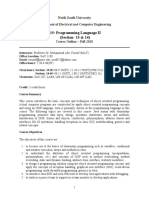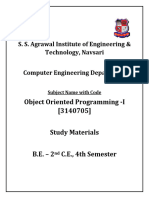0 ratings0% found this document useful (0 votes)
19 viewsCSE253 - Object Oriented Programming Using Java
Uploaded by
siddiquek463Copyright
© © All Rights Reserved
We take content rights seriously. If you suspect this is your content, claim it here.
Available Formats
Download as PDF, TXT or read online on Scribd
0 ratings0% found this document useful (0 votes)
19 viewsCSE253 - Object Oriented Programming Using Java
Uploaded by
siddiquek463Copyright
© © All Rights Reserved
We take content rights seriously. If you suspect this is your content, claim it here.
Available Formats
Download as PDF, TXT or read online on Scribd
You are on page 1/ 3
2.
1 Template A1: Syllabus for Theory Courses
School: School of Engineering and technology
Department Department of Computer Science and Engineering
Program: B.Tech
Branch:
1 Course Code CSE253
2 Course Title Object Oriented Programming Using Java
3 Credits 2
4 Contact 2-0-0
Hours
(L-T-P)
Course Core /Elective/Open Elective
Status
5 Course To learn Java language syntax and semantics and concepts such as
Objective classes, objects, inheritance, polymorphism and multithreading.
6 Course CO1. Define Object oriented programming concepts by identifying classes,
Outcomes objects, members of a class and relationships among them needed for a
specific problem.
CO2: Illustrate different features of java.
CO3: Develop Java programs to solve problems of applications using
OOP principles such as abstraction, polymorphism and inheritance.
CO4: Categorize runtime errors thrown in the application software or
generated runtime by applying the methods of exception handling.
CO5. Explain the concept of multithreading.
CO6. Design real life application using Java
7 Course Basic Object Oriented Programming (OOP) concepts including
Description objects, classes, methods, parameter passing, information hiding,
inheritance and polymorphism are discussed.
8 Outline syllabus CO Mapping
Unit 1 Introduction to Object Oriented Paradigm
A Introduction to OOP, Characteristics of OOP, CO1, CO2
Difference between OOP and procedural languages
B Byte Code, Architecture of JVM CO1, CO2
C Features of Java, Class Loader Execution Engine, CO1, CO2
Garbage collection.
Unit 2 Introduction to Java
A Classes, Objects ,Constructors, Methods CO1,CO2
B Constants, Variables, Data Types, Operators, CO1, CO2
Expressions, Decision Making Branching, Loops
C Arrays CO1, CO2
Unit 3 Polymorphism & String handling
A Polymorphism, method overloading CO3
B Constructors overloading , Wrapper class ,Type CO3
conversion & casting,
C Strings and String handling, CO3
Unit 4 Inheritance
A Inheritance, Types of inheritance, Overriding CO3,CO6
methods, use of this and super
B Constructor call in inheritance, Abstract class , CO3,CO6
Concept of multiple inheritance in Java
C Final class, method and variable, Interface, Access CO3,CO6
Modifiers
Unit 5 Exception and Multithreading
A Introduction to Exception Handling, Introduction to try, CO4,CO6
catch, Finally , throw and throws
B Checked and Unchecked exceptions, User define CO4,CO6
exception
C Introduction to Multithreading, Creating thread using CO5,CO6
Runnable interface and Thread class, Thread life cycle
Mode of Theory/Jury/Practical/Viva
examination
Weightage CA MTE ETE
Distribution 30% 20% 50%
Text book/s* 1.Schildt H, “The Complete Reference JAVA2”, TMH
Other
References 1. Balagurusamy E, “Programming in JAVA”, TMH
2. Professional Java Programming: BrettSpell, WROX
Publication
CO and PO Mapping
S. Course Program Outcomes (PO) & Program Specific Outcomes (PSO)
No. Outcome
1. Define Object PO5,PO12
oriented
programming
concepts by
identifying
classes, objects,
members of a
class and
relationships
among them
needed for a
specific
problem.
2. Illustrate different PO5
features of java.
3. Develop Java PO1,PO2,PO3,PO5,PO9,PO12,PSO1,PSO2
programs to
solve problems
of applications
using OOP
principles such
as abstraction,
polymorphism
and inheritance.
4. Categorize PO5
runtime errors
thrown in the
application
software or
generated
runtime by
applying the
methods of
exception
handling and
File I/O
5. Explain the PO5
concept of
multithreading.
6. Design real life PO1,PO2,PO3,PO5,PO6,PO7,PO9,PO11,PO12,PSO1,PSO2,PSO3
application using
Java.
PO and PSO mapping with level of strength for Course Name Object Oriented
Programming Using Java (Course Code CSE243)
Course Code_ PO PO PO PO PO PSO
CO’s
Course Name PO 1 2 3 PO4 PO 5 PO 6 PO 7 PO 8 PO 9 10 11 12 1 PSO2 PSO3
2 2
CO1
2
CO2
2 3 3 2 3 2 2 3
CO3
CSE253_ 2
Object CO4
2
Oriented CO5
Programming 3 3 3 2 3 2 3 2 3 3 3 2
Using Java CO6
Average of non-zeros entry in following table (should be auto calculated).
Course Course PO PO PO PO PO PO PO PO PO PO PO PO PSO PSO PSO
Code Name 1 2 3 4 5 6 7 8 9 10 11 12 1 2 3
Object
Oriented
CSE 253 Programm
ing Using
Java 2.5 3 3 0 2 3 2 0 3 0 2 2.3 2.5 3 2
Strength of Correlation
1. Addressed to Slight (Low=1) extent 2. Addressed to Moderate (Medium=2) extent
3. Addressed to Substantial (High=3) extent
You might also like
- Object-Oriented Programming Through JavaNo ratings yetObject-Oriented Programming Through Java12 pages
- 24CSE102_Object Oriented Programming_ 1st Sem_CPSNo ratings yet24CSE102_Object Oriented Programming_ 1st Sem_CPS3 pages
- 1010206201_Object Oriented Programming Using Java (T)No ratings yet1010206201_Object Oriented Programming Using Java (T)4 pages
- Syllabus of B.Tech (CSE) 2nd Year - With CO and PO MappingNo ratings yetSyllabus of B.Tech (CSE) 2nd Year - With CO and PO Mapping27 pages
- Object Oriented Programming through JAVANo ratings yetObject Oriented Programming through JAVA3 pages
- 21SC1203 Computational Thinking For Object Oriented Design ModifiedNo ratings yet21SC1203 Computational Thinking For Object Oriented Design Modified2 pages
- EEI3262 Introduction To Object Oriented Programming - Course SynopsisNo ratings yetEEI3262 Introduction To Object Oriented Programming - Course Synopsis2 pages
- Course-Outline of Java Programming CS 403No ratings yetCourse-Outline of Java Programming CS 4039 pages
- T4 14011102-4 Object Oriented ProgrammingNo ratings yetT4 14011102-4 Object Oriented Programming7 pages
- Object Oriented Programming through JAVA (1)No ratings yetObject Oriented Programming through JAVA (1)129 pages
- Pre-Requisites: Course Objectives: Course ObjectivesNo ratings yetPre-Requisites: Course Objectives: Course Objectives4 pages
- Object Oriented Programming Through JavaNo ratings yetObject Oriented Programming Through Java130 pages
























































